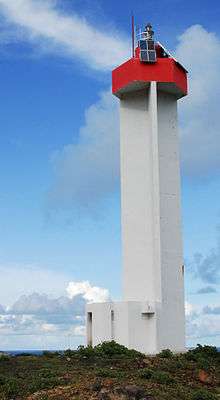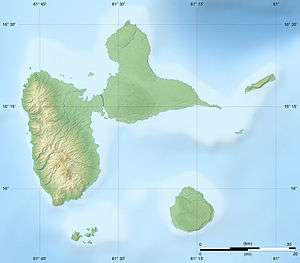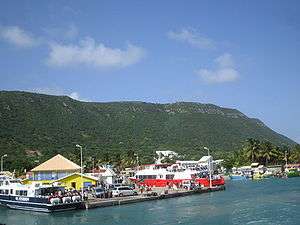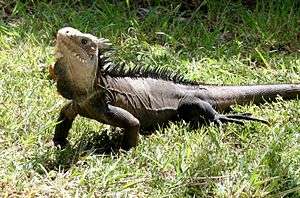La Désirade

 Pointe Doublé lighthouse in 2009 | |
 Guadeloupe | |
| Location |
La Désirade Guadeloupe France |
|---|---|
| Coordinates | 16°20′0.4″N 61°0′20.1″W / 16.333444°N 61.005583°W |
| Year first constructed | 1933 (first) |
| Automated | 1972 |
| Construction |
concrete tower (current) cast iron skeletal tower (first) |
| Tower shape |
triangular prism tower with hexagonal prism balcony, lantern atop a pedestal (current) hexagonal pyramidal skeletal tower with balcony and lantern (first) |
| Markings / pattern | white tower, red balcony and pedestal (current) |
| Height | 20 metres (66 ft) |
| Focal height | 50 metres (160 ft) |
| Light source | solar power |
| Range | 20 nautical miles (37 km; 23 mi) |
| Characteristic | Fl (2) W 10s. |
| Admiralty number | J5724 |
| NGA number | 14812 |
| ARLHS number | GUA-005[1][2] |
La Désirade is an island in the French West Indies. It is a part of Guadeloupe (a "dependency"), which itself is an Overseas Region of France.
Geography and geology
The island of La Désirade is located at the eastern end of Guadeloupe island group, in the Lesser Antilles. It lies about 8 km off the coast of Grande-Terre, which is the eastern half of the island of Guadeloupe. Its coordinates are 16°19′N 61°3′W / 16.317°N 61.050°WCoordinates: 16°19′N 61°3′W / 16.317°N 61.050°W.
The island is 11 km long and 2 km wide; the interior of the island forms a central plateau.[3] It has a land area of 20.64 km2 (7.97 sq mi) and a population of 1,595 in 2006, with a population density of 77 inh. per km² (200 inh. per sq. mile) in 2006. Most residents live in the settlement of Beauséjour (formerly known as Grande-Anse).
Geologically speaking, La Désirade is the oldest island in the Lesser Antilles with its most ancient rocks, at 145 million years old,[4] being found at the easternmost point of the island. The beach at Pointe Doublé is frequently visited by geologists who come to examine the basalt and composite rocks, which give the area its striking multi-coloured appearance. The island has its own lapidary, which transforms the rocks found on the island into jewellery and souvenirs.
Administration
The island of La Désirade is part of the French West Indies. In particular, it is a part of Guadeloupe department, which is one of the Overseas departments and territories of France. Local administration is carried out by the local commune (municipality). The commune of La Désirade also includes the uninhabited Petite Terre Islands which lie nearby.
Main settlements


Beauséjour
The main settlement on the island is the village of Beauséjour, which has a Post Office, a library, several grocery stores and restaurants, as also the community’s church, which is famous for its altar carved out of locally grown pear tree wood. The central square of the village is named ‘La Place du Maire mendiant’ (‘The begging Mayor’s square’), in memory of a beloved local figure. The ‘begging Mayor’ was the nickname given to a former Mayor, Joseph Daney de Marcillac, who, after a terrible fire had destroyed most of the village in 1922, went from door to door in Guadeloupe begging for funds and building materials in order to rebuild the two primary schools of the village.[5]
Close to the square, one can find a statue of the French abolitionist Victor Schœlcher, as also a monument in memory of the fishermen who perished at sea and the town hall, built in the style of architect Ali Tur.
Anse de Galets
This small bay is situated at the westernmost tip of the island, facing the Pointe des châteaux. Providing the departure point for the colonisation of the island, this cove was also home to all those who were exiled in the 18th Century.[6]
History
Archaeological evidence has been discovered that suggests that an Amerindian population lived on La Désirade from the 3rd to the 16th centuries.[7] Christopher Columbus was the first European to find La Désirade, this event occurred in 1493 on his second voyage to the region. In subsequent years, the island became known as a hiding place for pirates and eventually became site of a leper colony which was terminated in 1958. The western end of the island was used as a place of banishment for offenders of Grande-Terre and for some metropolitan nobles.
Culture
Festivals
The annual Sailors’ Commemorative Ceremony is held on 16 August. A large procession is taken out, in which the ‘Le Vétéran’, a model boat normally kept in the town’s church (Notre Dame de l’Assomption), is paraded all around Beauséjour. Though the ceremony itself is only for a day, the days leading up to and following it are normally festive too, with parades and parties. People from all over Guadeloupe and France come over to the island to partake in the event.
Every year the "Goat Festival" (Fête du Cabri) takes place during the Easter weekend. Based around a celebration of the island's favourite food, various concerts, productions and programmes are held across the isle.
Cuisine
The island is renowned for its fresh seafood, much of which goes straight from the fishing boats to the local restaurants. Furthermore, the lobsters and shellfish which are plentiful on Désirade are becoming increasingly rare in Guadeloupe as a whole. There are also many traditional goat recipes, including curries and stews, which make up a large part of the island's cuisine. As for desserts, the cashew fruit is a particular speciality which can be consumed on its own, with ice-cream or in rum-based drinks.
Flora and fauna
The island is in pristine condition, and is partly under the Réserve naturelle nationale de La Désirade. It provides a good opportunity to see varied and often rare wildlife. While the arid soil on La Montagne's plateau does not permit cultivation beyond subsistence level, the natural vegetation is amazingly rich and varied. Some of the plant species found are the gaïac (Guaiacum officinale), the mapou (Myrsine australis) and the cashew tree (Anacardium occidentale), as well as a protected species of cacti called the "tête à l’Anglais" (in reference to its similarity to the Queen’s Guards’ bearskin hats). This same region is also inhabited by rare animal species such as a type of robin called a ‘bicloitin’, a tropical rodent with glossy brown, orange fur named an ‘agouti’ (Dasiprocta) and the famous iguana, a herbivorous lizard whose colours range from bright apple-green to dark grey.
The two islets of Petite Terre (Terre de Bas, the larger of the two, and Terre de Haut) were designated as a natural reserve in 1998. The two islets are separated by a lagoon 200 yards across and are located about seven miles from Désirade, to which they belong administratively. In 1974 the lighthouse keeper and his family, the last residents, left Petite Terre due to the automation of the lighthouse. In earlier times, as many as 50 inhabitants lived on the islets. Today this tiny archipelago, surrounded by clear waters and huge coral reefs is inhabited by iguanas (Iguana delicatissima), which are native to the Lesser Antilles. Petite Terre is home to rare species of birds such as the Least Tern (Sternula antillarum), the American Oystercatcher (Haematopus palliatus), as well as various types of sandpipers. Two species of turtle, the Green Sea Turtle (Chelonia mydas) and the Loggerhead Sea Turtle (Caretta caretta), come to the islets to lay their eggs. Tourism is regulated by the National Office of Forests,[8] in partnership with the Désiradian association of Ti Tè.
See also
Notes
- ↑ La Désirade The Lighthouse Directory. University of North Carolina at Chapel Hill. Retrieved 29 August 2016
- ↑ List of Lights, Buoys and Fog Signals Atlantic Coast. Retrieved 29 August 2016
- ↑ Sullivan, Lynne M. Martinique, Guadeloupe, Dominica & St. Lucia, Hunter Publishing Inc., ISBN 1-55650-857-3, p. 345
- ↑ http://www.guadeloupensites.com/desirade.php
- ↑ http://www.guadeloupe-fr.com/magazinedestinationguadeloupe/article=25771/
- ↑ Gwadloup Natures, Desirade Natures, ISSN 1627-0142
- ↑ "Les dépendances". Guadeloupe Government webpage. Guadeloupe Government webpage. Archived from the original on 26 December 2013. Retrieved 9 April 2013.
- ↑ http://www.onf.fr/guadeloupe/onf_guadeloupe/patrimoine/reserve_naturelle/petite_terre/20080303-133055-641792/@@index.html Archived 1 July 2015 at the Wayback Machine.
External links
| Wikimedia Commons has media related to La Désirade. |
- The official website of the island
- Tourism website for the island
- Facebook page
- Desirade-sante.com Everything you should know about the major public health crisis that occurred in La Désirade.